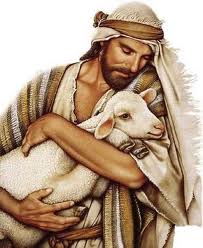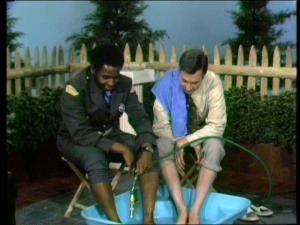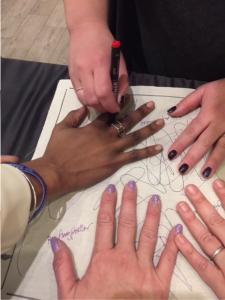Believe (Relational)
John 10:1-10
Well, here we are. We’ve made it through the darkness of Lent and have emerged, squinting in the bright light of resurrection. If we’re paying attention, we should be feeling a bit of disorientation. We’ve hung onto Jesus through death and now into life and, frankly, it’s all a little bit unbelievable.
 It’s so disconcerting that I think it may be a good thing we aren’t the first ones to live through this. Two thousand years ago around this time there was a group of disciples gathered, silent and tense in their fear, eyes meeting across the locked room, each wondering if he could even dare to believe what seemed to be so very, very unbelievable.
It’s so disconcerting that I think it may be a good thing we aren’t the first ones to live through this. Two thousand years ago around this time there was a group of disciples gathered, silent and tense in their fear, eyes meeting across the locked room, each wondering if he could even dare to believe what seemed to be so very, very unbelievable.
In the 2000+ intervening years, we, the church, have done our level best to tamp down that uncertainty and fear. We’ve worked very hard to explain, categorize, canonize, quantify, codify, mandate…what it means to believe. We’ve carefully defined the way we know who believes what, how it’s done, and definitely…how it’s not done.
We mean well. Really, we do. We are trying so hard to answer the fear, to make it manageable. But in the process I think we may be forgetting that sitting around that locked room 2000 years ago was a whole beautiful, conflicted group of Jesus followers who struggled mightily to find their own individual ways to step out of the painful reality of their human experience into the reign of God, and to begin to believe.
They didn’t all believe in the same exact way. And neither do we.
So here we are, in the light of Easter, wondering about what it’s going to take to believe. Not in the, “I’m showing up at church with a smile on my face and faking it,” but more like “I want to believe, but deep inside sometimes I wonder if I can really, really believe—am I the only one who feels this way?”
Today we’re talking about one way in which the first disciples of Jesus came to believe, a way in which some of us find our way to just enough light for the next step. Today we’re talking about relationships—about how the courage to believe, the presence of God, comes to us through each other.
Informing our thinking today are some words of Jesus from the gospel of John. They come to us on what is known in the church calendar as Good Shepherd Sunday, where we welcome the image of Jesus as the good shepherd and listen again to the words of Psalm 23. There’s a lot of art that has come from this image of Jesus as the Good Shepherd, including the picture many of saw hanging in the church nursery growing up. Jesus, robes flowing, hair wind-tousled, holding a little white fluffy lamb in his arms. You know the painting I mean, right? It’s all so sweet and pastoral and wonderful. What’s not to believe?
But if you take a little closer look at John’s gospel in chapter ten, you’ll quickly see there’s something almost urgent and compelling in his words—almost a life and death tone in this parable. Instead of fluffy little lambs, John describes a sheepfold, protection for sheep, and a shepherd who cares for them in the middle of danger. He uses scary words like, “Thief, bandit, stranger, steal, kill, destroy”—words that paint a picture of sheer peril all around, and the tender care and direction that come from life-giving relationship in community. You could say: enough relationship to believe that the danger all around will not engulf you forever.
Whenever the calendar rolls around to Good Shepherd Sunday I can’t help but think of one year of my life when I lived on the north island of New Zealand. Auckland, New Zealand was actually the perfect place for an angst ridden fifteen year old to spend a year away from her parents as a foreign exchange student. With acres and acres of rolling hills dotted with sheep there was very little urban mischief available; everything was peaceful and beautiful and…a little bit boring. But even through teenaged eyes I could see the beauty of the sheep farms in the countryside, and was excited when my host family announced that I’d have the opportunity to spend the week on a sheep farm. I’d get to be up close to the sheep, to see how the farm was run, to help the farmer count and tag the lambs, to eat fresh cheese made right there on the farm. I couldn’t wait.
The first day in, I began to suspect that something was not as…pastoral, shall we say?, as I had imagined. My first clue came when the farmer’s wife gave me a pair of rubber boots and asked me to go into the chicken coop to collect the eggs. Sounds like fun, right? Yes, well the smell in the chicken coop was not the greatest, and the hens were largely unhappy with my egg collection efforts. As I stepped out of the coop, brushing hay out of my hair, my foot landed in a very deep puddle of something that looked like mud but smelled suspiciously like something else. And my boots sank like the ground was quicksand under me, and the muck covered the top of the boots and filled them.
And that experience was just the start. Turns out taking care of sheep is hard and sweaty work; they have to be sheared and vaccinated, corralled and protected—the work to make sure they are safe and thriving is constant and backbreaking. And given the exhaustion of each day, I can’t remember savoring homemade cheese at all; I just fell into bed every night so tired by the work it took to tend that little farm.
But in sweat and work and sickness and muck of that sheep farm, there were shepherds, who worked constantly to nurture and protect the sheep, to help them know where to go and what to eat so that they produced the very best wool and cheese, and covered the hills with those fluffy lambs that look so cute from far away.
As I remember the stark contrast of that experience, I observe that there is true distinction between the nursery picture of Jesus and the lamb, and the reality of a shepherd’s work. And that stark contrast Jesus names speaks to the heart of what it means to nurture Christian community in which we come to believe. Because you and I know, even if we can’t really say it out loud without feeling the tears well up, that this world can be a brutal place.
There is much about the human experience—and even our experiences in the institutional church—that would lead us NOT to believe.
And…there are many, many things in faith community that help us keep believing.
As the light of resurrection pools around us this Eastertide, we can imagine ourselves in that upper room, sitting around that circle, wondering if we have the courage to step into an unknown future, to believe all the audacious claims of resurrection: that good will overcome evil, that life triumphs over death, that love is the very strongest thing there is, that God has not left us alone.
Maybe as those disciples sat tensely, fear-filled in that room, they remembered meals they had shared together, where they broke bread and buoyed each other’s flagging hopes.
And, like them, maybe you and I can think of times when the tender grace of our community helped us believe, even in the middle of terrible peril or grief or doubt or pain. Even in all the muck of life.
Maybe it happened for you when the pastor pulled you up out of the water, dripping, and said you were to go and be a light in the world. Perhaps you feel it when you hear the absolution after confession: “You are loved, you are forgiven, be at peace.” Maybe it happened when you joined the church and heard the voices of your friends promising to walk with you on this journey. What about that awkward few weeks of passing the peace, when people who are dearly beloved and only vaguely familiar offer words you’d never hear anywhere else: the peace of the Lord be with you?
I know it happened for me just a few weeks ago when our children offered me grapes and goldfish—a special kind of communion—and I heard Isaiah Harris Love say to me, “This is for you!”
The tender care of our community helps us believe.
A Marianite sister who was a spiritual mentor to me early in my ministry work liked to say that Jesus was “God with skin on”—a unique characteristic of the Christian faith in which we had the gift of God, here, teaching us in person how to care for each other. In John’s gospel when Jesus tells the parable of a shepherd, he’s not suggesting we’re a sad, vulnerable, ignorant lot, ready at any minute to be thrown to the despair and destruction of hopeless indifference unless we are saved by something outside.
He’s saying: “Let me show you how to shepherd each other. This is how you tend a community in which we can thrive and love and heal and believe. Together.”
Because life in this world is not a benign experiment. The human experience is gritty and painful; sometimes it will steal our hope and chip away at our faith. But in following the shepherd who came to show us how to care for each other in the muck and pain of it all, sometimes we help each other believe.
A story is told in my circles about Carlisle Marney, a Southern Baptist preacher from Tennessee who was a compelling and prophetic voice of the church in the middle of last century. He was preaching a revival at First Baptist Church of Greenville, SC years ago. As the pastor of the church drove Dr. Marney back to the hotel after the revival service one night, the pastor joked, “To hear you talk about resurrection made me think that if I didn’t know any better, I’d say you actually believed!”, to which Marney quickly replied “What you can believe depends largely on the company you keep.”
Sometimes, in the tender care of a faith community, we help each other believe.
Just a little more light, just a hand to hold onto, just the next foothold, just enough to keep going—we offer these by shepherding each other in the way of our Savior, the Good Shepherd, who offers in the face of thieves, and bandits, strangers who steal, kill, and destroy, instead: a familiar voice, a well-worn path, a pasture of sustenance, a life abundant.
Just enough to believe.
May it be so.











